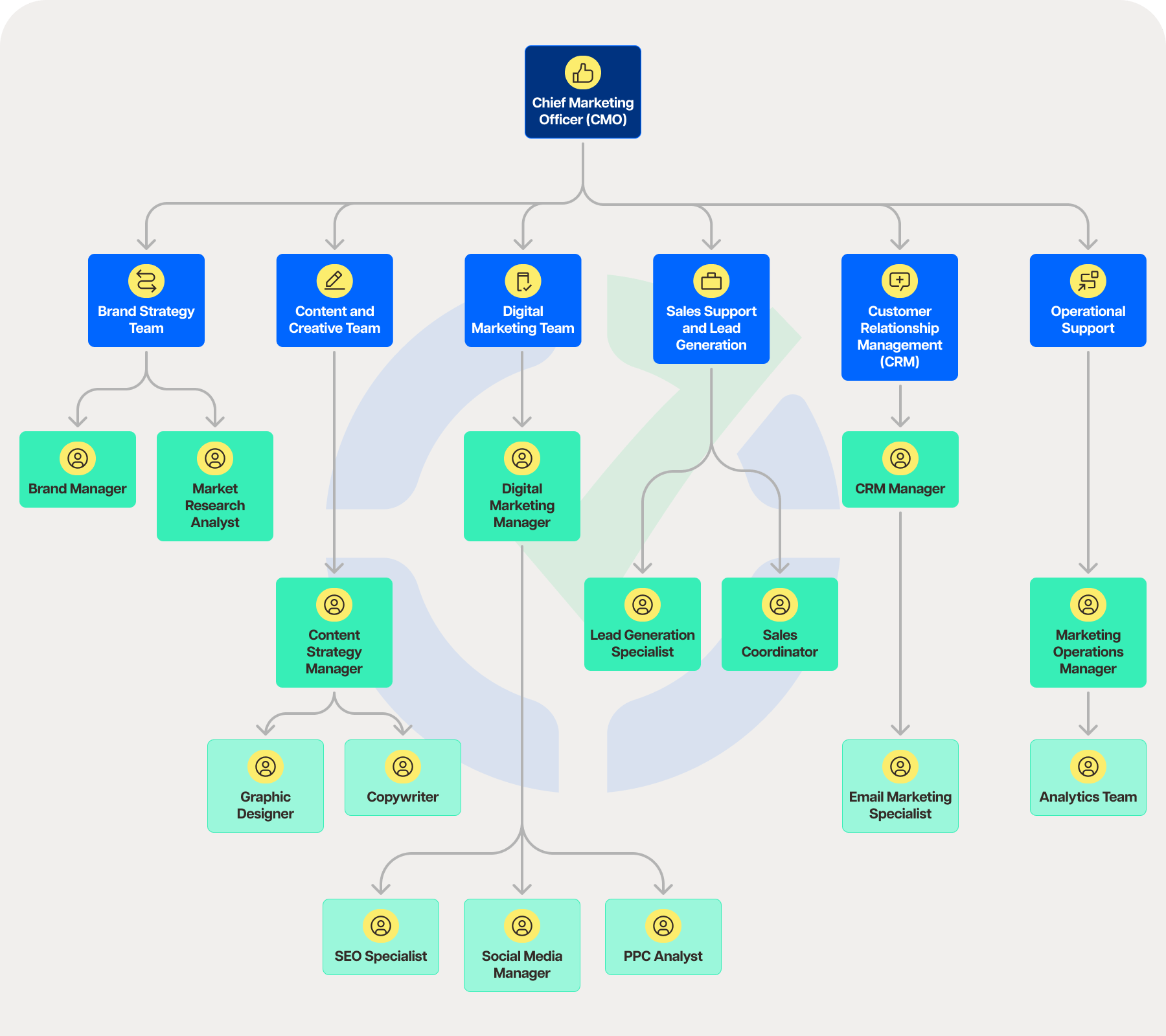The structure of a company’s marketing team is critically important to its success. A well-designed marketing team structure ensures a strong and organized approach to maximizing the impact of branding, digital marketing, content creation, and customer engagement strategies. It also facilitates the team’s ability to keep pace with the constantly evolving marketing landscape.
This introduction sets the stage for a more in-depth exploration of how a strategically organized marketing team can swiftly and effectively respond to customer habits and market trends, becoming a potent force for growth, innovation, and competitive advantage.
Table of Contents
- Core objectives of a marketing team
- Key components of an efficient marketing team structure
- Sample marketing team structure
- Building the team
- Challenges and solutions
- Future of marketing teams
Core objectives of a marketing team
A business’s growth depends on its marketing team’s goals. Marketing plans are based on these objectives, each of which drives the organization ahead.
Branding and identity
Company brand and identity are its heartbeat. A marketing team creates a unique brand that connects with its target audience and sets it apart from rivals. This requires creating a brand voice, personality, and graphics that are consistent across marketing platforms.
Market research and analysis
Market knowledge is essential for marketing success. Data about rivals and consumers is collected, analyzed, and interpreted in market research and analysis. This goal provides data-driven marketing decisions based on market demands, trends, and growth prospects.
Content creation and distribution
Content dominates digital contact with new and existing clients. Marketing team aims to provide meaningful, relevant, and consistent content that attracts and keeps a specified audience. Utilising distribution channels ensures this material engages and drives lucrative consumer action.
Digital marketing and social media management
In a digital era, online presence and engagement are essential. Digital marketing and social media management promote brands, products, and services online. This encompasses SEO, PPC, email marketing, and social media to connect with customers.
Lead generation and sales support
Many marketing operations strive to create sales-ready leads. Marketing teams create and execute strategies to drive prospects through the sales funnel. Sales assistance gives salespeople the tools, materials, and leads they need to close deals.
CRM: Customer relations
Post-sale client connections are crucial for retention and loyalty. CRM uses data analysis of customers’ past interactions to strengthen business connections, concentrating on customer retention and sales growth.
These basic objectives help a marketing team create a solid, logical, and successful plan that supports company goals. A holistic strategy enhances brand growth, customer engagement, and market competitiveness by connecting all elements.

Key components of an efficient marketing team structure
Modern marketing is complicated and dynamic, thus a good marketing team structure is essential. This structure supports the company’s strategic goals and boosts team productivity and innovation. An effective marketing team structure includes
Flexibility and scalability
In today’s fast-paced economy, adaptability and scaling are essential. An effective marketing team structure adapts to market conditions, customer behaviour, and technology. This involves scaling up successful campaigns or pivoting strategy fast in response to feedback or market research without affecting workflow.
Clear roles and responsibilities
Clear roles and responsibilities help team members understand their jobs, how they contribute to marketing goals, and who they need to work with. Clear communication reduces overlap, streamlines process, and boosts accountability and productivity. It also empowers team members by providing them task ownership and domain decision-making power.
Integration of creative and analytical talents
Creativity and analytics fuel marketing. An effective team combines creative (graphic designers, copywriters, and content providers) with analytical (market researchers, data analysts, and digital strategists). Integration of data-driven insights into creative initiatives creates more successful and quantifiable marketing tactics.
Communication and collaboration channels
Communication and teamwork are key to any effective marketing team. Clear communication and collaboration channels promote team-wide sharing of ideas, comments, and information. Regular meetings, project management tools, and an open, inclusive workplace can help. Innovation and idea sharing thrive in such an environment.
Use of technology and automation tools
In the age of digital marketing, technology and automation may boost team productivity. These solutions may simplify operations, eliminate manual processes, and deliver actionable information, from CRM and analytics platforms to CMS and automation software. An efficient marketing team uses these technologies to improve operations, tailor consumer experiences, and assess campaign performance.
These important components improve a marketing team’s capacity to execute effective campaigns and establish a resilient foundation that can resist digital marketing obstacles. It helps teams be more nimble, focused, and aligned with strategic goals, boosting market growth and competitiveness.

Sample marketing team structure
Marketing team structure should match company goals, methods, and size. A marketing team with balanced strategic, creative, and operational activities and divisions is shown below.
I. Executive level
Chief Marketing Officer (CMO): The CMO manages marketing strategy and implementation. This person sets marketing goals, aligns tactics with company goals, and maximizes marketing budget ROI.
II. Strategic segments
Brand strategy team
Brand manager oversees strategy, direction, and identity. It ensures brand consistency across marketing channels and brand message alignment with business values and goals.
Market Research Analyst: Finds trends, opportunities, and competitors by analyzing market data. Results inform marketing strategy.
Creative/content team
- content strategy manager:Develops and distributes content across platforms. Content scheduling, brand voice compliance, and evaluation are required.
- Graphic designer: Makes brand-focused digital and print visuals. Includes website, social media, commercial, and marketing graphics.
- Copywriter: Writes action-packed copy. Website, blog, email, and ad content.
Digital marketing team
- Digital Marketing Manager: As the digital marketing team manager, you plan, implement, and evaluate initiatives. This job boosts online conversions using SEO, PPC, and social media experts.
- SEO Specialist: Increases website traffic by optimizing content. Link-building, keyword research, and on-page SEO are involved.
- Social media managers: Oversee strategy and interaction across platforms. This job requires social media analytics, content planning, and community participation.
- PPC analysts: Design, manage, and optimize pay-per-click advertising to maximize ROI.
Sales support and lead generation
- Lead generation specialist:Provides sales support and creates multi-channel lead generation initiatives. This job funnels sales leads.
- Sales coordinator: Gives sales team marketing materials, statistics, and insights.
Customer Relationship Management (CRM)
- CRM managers: Strengthen business connections and retention by managing customer interactions and data analysis. This position requires CRM software management and client service.
- Email marketing specialist: Engages subscribers, markets items, and boosts revenue using email campaigns.

III. Operation support
Marketing operations manager
Enhances tech and procedures. This role optimises marketing operations by managing technological stack, procedures, and data.
Analytics team
Data analysis guides marketing. Campaign results, website analytics, and consumer behavior analytics inform strategy.
This sample marketing team includes strategy, brand management, content, digital marketing, and customer engagement. The marketing strategy-aligned sectors specialize in distinct activities. The framework allows teams to adapt to changing marketing trends and technology and collaborate across disciplines to create efficient marketing operations.
Building the team
Building a powerhouse marketing team involves:
- Hiring strategies for versatile talent: Looking for individuals who can wear multiple hats and adapt to various roles.
- Training and development for team synergy: Investing in training to enhance skills and ensure all team members are aligned with the brand’s vision.
- Implementing technology for efficiency: Utilizing software and tools that enhance productivity and creativity.
Building a marketing team with these considerations in mind ensures not only that the team is well-equipped to handle the current marketing landscape but also that it is prepared to adapt and thrive amidst future changes. By prioritizing versatility, continuous learning, and technological proficiency, organizations can create a marketing team that drives sustained growth and success.
Challenges and solutions
Building and maintaining an efficient marketing team involves navigating a series of challenges that can arise from team structuring and operation. Addressing these challenges head-on with strategic solutions ensures the team remains dynamic, cohesive, and effective in achieving its goals.
Challenges in team structuring and operation
- Siloed departments: Marketing teams often face the challenge of working in silos, where different segments of the team operate independently without sufficient collaboration or communication. This can lead to disjointed strategies and inefficiencies.
- Keeping up with rapid technological changes: The fast pace of technological advancement can overwhelm marketing teams, making it difficult to stay current with the latest tools and trends that could enhance their strategies.
- Talent retention and development: Attracting and retaining top talent while ensuring their growth and satisfaction within the team can be a significant challenge. This is especially true in competitive markets where skilled marketers have numerous opportunities.
- Resource allocation: Efficiently allocating limited resources, including budgets, tools, and team members’ time, can be challenging, particularly for teams with ambitious goals and multiple ongoing projects.
- Measuring ROI and performance: Demonstrating the return on investment (ROI) of marketing activities and accurately measuring team performance against objectives can be complex, especially with longer-term branding strategies or in digital landscapes with vast data.
Strategies for overcoming these challenges
Overcoming siloed departments
- Foster cross-functional collaboration: Encourage regular communication and collaboration between different segments of the marketing team and other departments. This can be facilitated through joint meetings, shared projects, and integrated planning sessions.
- Unified strategy: Develop and communicate a unified marketing strategy that aligns all team members towards common goals, ensuring that individual efforts contribute to the overall objectives.
Keeping up with technological changes
- Continuous learning: Allocate time and resources for team members to engage in ongoing education and training on new technologies and marketing trends.
- Innovation time: Implement a policy that allows team members to spend a portion of their time exploring new tools, techniques, and strategies that could benefit the team.
Talent retention and development
- Career path planning: Work with each team member to develop clear career paths and growth opportunities within the organization.
- Recognition and reward: Implement a system for recognizing and rewarding contributions and achievements, fostering a positive and motivating work environment.
Efficient resource allocation
- Strategic planning: Use strategic planning to prioritize projects and initiatives based on their potential impact and alignment with overall business goals.
- Agile methodologies: Adopt agile methodologies that allow for flexibility in project management and resource allocation, enabling the team to adapt to changes and pivot strategies as needed.
Measuring ROI and performance
- Define key performance indicators (KPIs): Clearly define and communicate the KPIs that will be used to measure success, ensuring they are aligned with the team’s goals and objectives.
- Leverage analytics tools: Invest in analytics tools that provide detailed insights into performance, allowing for data-driven decision-making and strategy adjustments.
Marketing teams can improve their structure and processes by taking proactive steps to deal with these common problems. This will lead to higher efficiency, team cohesion, and total performance. This not only helps the team reach their short-term business goals, but it also sets them up for long-term success in a competitive market.
Future of marketing teams
When we think about the future, marketing teams are about to go through big changes. These changes will be caused by technologies that change quickly, changing customer habits, and the growing importance of making decisions based on data. These changes will have an effect on both how marketing teams work and how they are set up.
It’s possible that speed, data analytics, and marketing strategies that focus on customers will become even more important in the future. To stay ahead, teams need to be able to change, keep improving their skills, and be open to new tools.
Conclusion
To get the most out of your marketing, you need to make sure that your team is structured well and is dedicated to new ideas and constant growth. Encourage your team to be open to change and to keep learning. Also, create an environment where both creative ideas and plans based on facts can grow. Your marketing team will be ready to take your company to new heights of success once these things are in place.

Andy is a technology & marketing leader who has delivered award-winning and world-first experiences.


